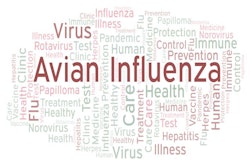
Following a sharp increase in the number of cases of highly pathogenic avian influenza (HPAI), the agriculture ministry in France has introduced strict new measures to control the spread of infection.
Since the country’s first HPAI outbreak of the winter season at the end of November, the agriculture ministry in France has recorded 251 outbreaks of the disease in poultry (as of January 21). Furthermore, the H5N1 serotype of the virus has been detected in six backyard flocks as well as 22 wild birds.
A particular aspect of concern is the rapid spread of infection in the southwestern region. During the 2020-2021 winter and into the following months, the ministry reported that 3.5 million poultry — mainly ducks in southwestern departments of France — were culled to prevent the spread of the H5N8 HPAI virus.
As of January 18 in 2021, 291 outbreaks were already confirmed in that region. On the same date this year, there had been 216 outbreaks.
Challenged by a different virus serotype — H5N1 — this season, the agriculture ministry has taken early action to avoid a similar catastrophe in 2022. In areas where multiple outbreaks occur, preventative culling of all poultry and waterfowl will now be carried out. As well as reducing the risk of spreading the virus further, this measure aims to allow the earlier restocking of depleted farms.
Currently, the area subject to preventative depopulation of poultry covers 226 municipalities. This includes 161 communities in the department of Landes, 39 in Gers, and 26 in Pyrénées-Atlantiques.
According to the ministry, these new measures will require additional resources. These are required to carry out depopulation of farms, and to implement additional biosecurity protocols for the transportation of poultry in the affected areas. To facilitate restocking after the crisis, breeder flocks and hatcheries will be protected as far as possible, according to the ministry.
Under the new disease control arrangements, poultry owners whose birds are culled preventatively will receive financial compensation under the same terms as last year.
65 new outbreaks in French poultry flocks
Over the past week, France’s veterinary authority has officially registered 65 new outbreaks of HPAI in poultry. According to the report to the World Organisation for Animal Health (OIE), these directly involved more than 371,000 birds, all from commercial farms. The presence of the H5N1 HPAI virus was confirmed at each location between December 30 and January 12. Of these latest outbreaks, 53 were in ducks, 10 in chickens, and two were flocks of mixed species.
As for locations of the outbreaks, the great majority were in the southwestern region of New Aquitaine (departments of Landes, Gers, Pyrénées-Atlantiques, and Lot-et-Garonne). In addition, there were a handful of outbreaks in the Occitanie region so the south-east (Hautes Pyrénées), and one to the north of New Aquitaine in Pays de la Loire (Vendee).
These latest outbreaks bring the seasonal total in France so far to 108 outbreaks, directly involving more than 941,000 birds.
First outbreaks registered in Spain
For the first time, the H5N1 HPAI virus has been detected in Spain.
Almost 1,000 birds died out of a flock of 18,900 meat turkeys in the province of Segovia earlier this month, according to the official OIE report.
Segovia is in the northwestern Spanish region of Castile and León.
The source of the infection on the farm is unknown. There have been no movements of poultry onto the farm since November of last year.
However, wild birds may have been carrying the virus. Since last month, some wild birds found dead in this region as well as in Catalonia have tested positive for the H5N1 virus, according to OIE.
Italian outbreak total passes 300
In Italy, the number of HPAI outbreaks in poultry linked to the H5N1 virus serotype has reached 308. This is according to the nation’s health authority and research organization for animal health and food safety, IZSVe (as of January 18).
Since the start of 2022, cases have been confirmed at 10 locations. Among these is the first outbreak in the Tuscany region, where a backyard flock tested positive for the virus in the province of Florence. The other affected premises were in Veneto and Lombardy, where previous cases have been detected since mid-October of last year.
According to information supplied to the OIE, the current HPAI wave in Italy has impacted more than 14.6 million poultry.
HPAI situation elsewhere in European poultry flocks
As of January 16, 10 European countries have registered one or more outbreaks in poultry with the Animal Disease Information System of the European Commission (EC). A total of 150 outbreaks have been submitted to the EC’s Animal Disease Information System.
Of the total, France has reported the most outbreaks (79), followed by Hungary (27), and Italy and Poland (each with 12).
Also reporting cases through the system have been Belgium, Bulgaria, Croatia, Czech Republic, Denmark, Germany and the Netherlands.
In the Central Region of Denmark, the H5N8 HPAI virus variant had remerged after an absence of around six months. In mid-January, a flock of 100,000 laying hens tested positive for this serotype, according to a recent report to the OIE.
Among the countries not covered by the EC system is the United Kingdom (U.K.), where first cases have been detected on the Isle of Man. The island is a British Crown dependency in the Irish Sea.
In five of its regions, the Russian veterinary authority has declared the HPAI situation in poultry “resolved.” This follows previous outbreaks in domestic birds in Kirov, Kursk, Rostov, Stavropol, and the Volga River basin.
Also declaring to the OIE an end to earlier H5N1 outbreak series in their respective poultry flocks have been the Republic of Ireland, and Ukraine (Kherson region).
Cases in European wild birds pass 340
Already by mid-January, the number of HPAI outbreaks in wild birds stood at 342. This is according to the EC animal disease system, as of January 16.
Of the 20 states registering cases through this system, Germany has detected the most outbreaks in wild species (152), followed by the Netherlands (58), and Slovenia (28).
Also with one or more cases so far this year were Austria, Belgium, Croatia, Czech Republic, Denmark, Finland, France, Hungary, Irish Republic, Italy, Luxembourg, Poland, Portugal, Romania, Slovakia, Spain, and Sweden.
View our continuing coverage of the global avian influenza situation.

















